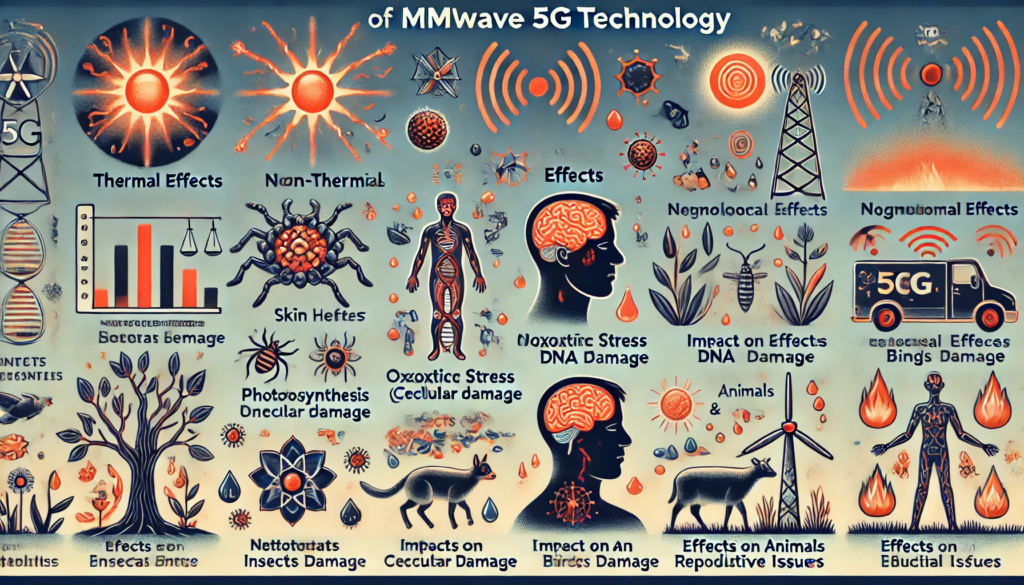Utilization of mmWave
5G Spectrum
The mmWave (millimeter wave) 5G spectrum refers to the high-band frequencies above 24 GHz. These frequencies can deliver extremely high data rates and low latency, making them ideal for supporting applications such as augmented reality (AR), virtual reality (VR), and the Internet of Things (IoT).
In India, a telecom giant has achieved peak speeds of 4.7 Gbps during testing on mmWave for 5G FWA (Fixed wireless access, or FWA, is a type of 5G or 4G LTE wireless technology that enables fixed broadband access using radio frequencies instead of cables). This showcases the potential of mmWave for addressing high network capacity demands.
Potential Side Effects of 5G
While the benefits of mmWave 5G are clear, concerns about potential health and environmental impacts are also significant. Research on the side effects of EMF (electromagnetic fields) and dirty electricity (unwanted electromagnetic frequencies produced by electrical devices) has highlighted several areas of concern. Below are some documented potential side effects based on peer-reviewed studies:
Health Effects on Humans

- Thermal Effects:
Study: “Biological effects of millimeter-wave irradiation” by Rojavin and Ziskin (1998).
Findings: Exposure to high levels of mmWave radiation can cause thermal effects, leading to skin heating and potential thermal injuries if safety limits are exceeded.
- Non-Thermal Effects:
Study: “Oxidative mechanisms of biological activity of low-intensity radiofrequency radiation” by Yakymenko et al. (2016).
Findings: Exposure to low-intensity RF radiation, including mmWaves, may cause oxidative stress, which can lead to DNA damage, cancer, and other health issues.
- Neurological Effects:
Study: “Electromagnetic fields and neurobehavioral function” by Lai (2007).
Findings: Chronic exposure to EMFs may affect cognitive functions and could be linked to neurodegenerative diseases.
Effects on Vegetation and Environment
- Impact on Plants:
Study: “Exposure of plants to microwaves and radiofrequency waves: A review” by Markov and Grigoriev (2013).
Findings: RF radiation can affect plant growth and development, with potential impacts on photosynthesis and cellular structure.
- Impact on Ecosystems:
Study: “Impacts of Radiofrequency Electromagnetic Fields (RF-EMF) from mobile phone base stations on wildlife: a review” by Balmori (2009).
Findings: RF-EMF exposure can disrupt insect navigation, alter bird migratory patterns, and affect animal behavior and reproductive health.
Effects on Animals and Birds

- Behavioral Changes in Animals:
Study: “Biological effects of electromagnetic fields on animals” by Havas and Colling (2011).
Findings: EMF exposure has been linked to behavioral changes, stress responses, and altered circadian rhythms in animals.
- Impact on Birds:
Study: “Radiofrequency radiation injures trees around mobile phone base stations” by Waldmann-Selsam et al. (2016).
Findings: Birds nesting near RF-EMF sources may experience reproductive issues and disorientation, potentially leading to population declines.
Conclusion
The deployment of mmWave 5G technology offers immense potential for high-speed connectivity and network capacity. However, the possible health and environmental impacts necessitate careful consideration and further research. The documented side effects from peer-reviewed studies underscore the importance of establishing stringent safety guidelines and conducting ongoing monitoring to mitigate potential risks associated with 5G technology.
